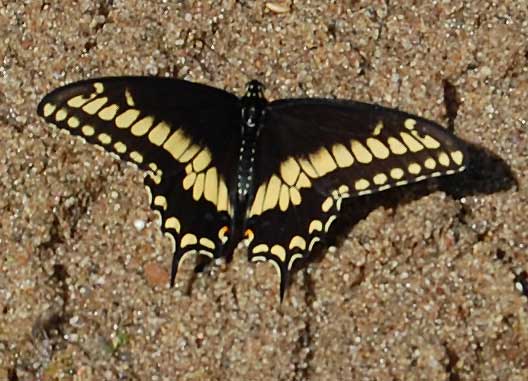Black Swallowtail
(Rudkin's Swallowtail)
Papilio polyxenes coloro
(Papilio rudkini)

Moist sand near the edge of the Hassayampa River in Yavapai County likely contains some dissolved salts - this is often the main attraction for butterflies. April 26, 2008.
Papilionidae -- Swallowtail Butterfly Family
Long before botanists recognized the relationship between plants of the Citrus Family and plants of the Carrot Family swallowtail butterflies were exploiting their chemical similarities. In most parts of North America where this butterfly is common, the caterpillar feeds on members of the carrot family. But in central Arizona the caterpillars instead feed on the foliage of Turpentine Broom, Thamnosma montana, a relative of citrus. This butterfly is also found in southeastern California, southern Nevada and Utah.
This subspecies of the Black Swallowtail is sometimes called the Desert Swallowtail. It is most common in mid-spring and occasionally males engage in ‘hilltopping’. Males seek the summit of small hills or mountains and there establish territories. A male that acquires and holds a larger summit patch has a better chance of mating with a receptive female because females after eclosing from their chrysalids fly towards such a small hilltop to select a mate. It is thought that such a system evolves where populations of an insect are at very low density. Hilltopping is thus seen as a way for the species to increase likelihood of meeting.
More Information:
- BugGuide Iowa State University.
- Butterflies of America
- Google Images
- Google Scholar Literature Search